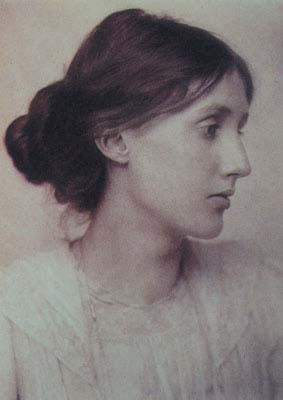Virginia Woolf
(1882-1941)
- 1882: Born Adeline Virginia Stephen in London to a British family of
letters (father wrote Dictionary of National Biography)
- 1895: Mother dies and experiences first mental breakdown; never
went to school but read extensively in her father’s library
- 1902: Father knighted (Sir Leslie Stephen)
- 1904: Father dies (second breakdown)
- 1905: Starts reviewing for the Times
Literary Supplement
- 1907: Brother Thoby dies
- 1908: Starts writing her (later, to be published) novels
- 1910: Gradual gathering of the Bloomsbury group (Leonard Woolf,
Clive Bell, Saxon Sydney-Turner, Lytton Strachey, and Maynard Keyne),
orig. based at house of her sister Vanessa Bell
- 1912: Marries Leonard Woolf
- 1913: Mental breakdown after marriage
- 1915: The Voyage Out
- 1917: Founds Hogarth Press
- 1918: End of WWI
- 1923: Meets (future lover) Vita
Sackville-West (Nicholson), the model for Orlando
- 1925: Mrs. Dalloway
- 1927: To the Lighthouse
- 1928: Orlando
- 1929: A Room of One’s Own
- 1931: The Waves
- 1941: Loads her pockets with stones and drowns herself in the
River Ouse
What
is Modernism?
-
not contemporary
-
ca. 1910-1930
- related to other artistic movements
(Surrealism, Cubism, Dada,
jazz, etc.)
What
is the novel?
-
Etymology: Middle English, from Middle French, new,
from Latin novellus, from
diminutive of novus new
(adjective);
Italian novella (noun)
- Definition: an invented prose narrative that is usually long
and
complex and deals especially with human experience through a
usually connected sequence of events
- Started as epistolary (Richardson, Clarissa)
- 18th century: the loss (and reclamation of) virtue (Defoe, Moll Flanders);
- 19th century: orphan rediscovers noble heritage / inheritance
(Bronte sisters); the Bildungsroman
(literally, novel of education;
journey of protagonist from
imprisonment of childhood toward
mature freedom
- Additional vocabulary: exposition, turning point(s), climax,
and denouement
Qualities of the Modern
European Novel:
- Open-ended
- Multiple narrative perspectives, unreliable narrators
- Experimental use of space and time
- Skeptical about and apt to write ironically about
“sincerity” and “authenticity” in art
- Use of dream, trance, and fantasy to express
the ineffable (limits of language)
- Demands a critical eye/I from the reader
(and a good sense of humor)
- Subject matter: the construction of the self,
suicide, love and infidelity
Orlando and Biography
1. Response to the 19th-century
Biography
- Leslie Stephen, English Dictionary of National
Biography (1885-1900):
so-called national character
2. Comment on Modern Revisions
- Lytton Strachey, Elizabeth and
Essex (1925/28),
Eminent
Victorians
(1918): Emphasis on biographer's
perspective
- Harold Nicholson (Vita Sackville-West's husband): Some People
- Woolf, "The New Biography:"
“if we think of truth as something of granite-like solidity
and of
personality as something of rainbow-like intangibility
and reflect that
the aim of biography
is to weld these two into one seamless whole, we
shall
admit that the problem is
a stiff one and that we need not wonder
if biographers
have for the most part failed
to solve it” (Collected
Essays, 4:229).
3. Vita Sackville-West, Knole
and the Sackvilles (1922)
3.1 Love Letters
Woolf’s letter to Sackville-West:
“it sprung upon me how I could revolutionise biography in a night . . .
suppose Orlando turns out to be Vita; and it['s] all about you and the
lusts
of your flesh and the lure of your mind (heart you have none, who
go
gallivanting down the lanes with [Mary] Campbell”
(8 Oct. 1927, The Letters of
Virginia Woolf, ed. Nigel Nicolson and Joanne Trautmann.
New
York: Harcourt. 3:428-29).
Vita Sackville-West after reading the book:
“you have invented a new form of Narcissism,--I confess,--
I am in love
with Orlando . . . “
(Letters of Vita Sackville-West.
Ed. Louise DeSalvo and Mitchell A. Leaska. New York: Morrow, 1985.
289).
3.2 Counterfeiting
- From Knole and the
Sackvilles:
“the white rose which was planted under
James I’s room has climbed
until it now reaches
beyond his windows on the first floor; the great
lime
has drooped its branches until they have
layered themselves in the
ground of their own accord
and grown up again with fresh roots into
three complete circles all sprung from the parent tree . . . “
(London:
Ernest Benn, 1958, p. 209)
- Also replete with letters, diaries, menus, purchase
invoices
- Vita S. W. won a prize for her poem, "The Land"
The country habit has me by the heart,
For he's bewitched for ever who has seen,
Not with his eyes but with his vision,
Spring
Flow down the woods and stipple leaves
with sun.
3.3. An English History
- As the last female heir to her family's estate, she had to move
out
and give the property over to a male relative.
- Family of poets, artists, and lovers that, by the 18th century,
has
become dominated by the feminine
- Thomas Sackville: treasurer to Queen Elizabeth and presented with
Knole in order to remain close to the monarch
- Charles Sackville: loved a mysterious Russian lady, took a gypsy
girl
for a wife
Journal #4:
Write a “biography” of Orlando based
on events
we know about his life up to this point in the novel.
Time limit ten minutes.

